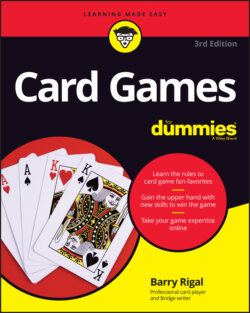Читать книгу Card Games For Dummies - Barry Rigal - Страница 36
Reserving Your Time for Canfield
ОглавлениеCanfield is one of the most commonly played Solitaires in the Western world. People often erroneously refer to this game as Klondike, which also appears in this chapter (see the following section, “Striking Gold with Klondike”). To further complicate matters, Canfield is also known as Demon Thirteen in the United Kingdom.
To set up Canfield, follow these simple steps:
1 Place 13 cards in a pile, with only the top card face-up; this pile is called the reserve or the heel.
2 To the right of the reserve, spread out four cards, called a tableau, on which you can build by using the cards from the reserve or the stock (the remaining 34 cards in the deck).
3 Above the tableau, place a single face-up card, which acts as the base card of a foundation from which each suit will be built up.
The object of Canfield is to get rid of all 13 cards in the reserve pile. You get rid of these cards by placing them in legal positions in the tableau.
You build on the tableau by placing a card that’s one rank lower and of the opposite color of the uppermost card. For example, you can legally put the ♣2 on either the ♥3 or ♦3. After the ♣2 is on the top of the pile, you can place either the ♥A or ♦A on it. If you place the ♦A on the ♣2, you can place either the ♣K or the ♠K on the ♦A, and so on.
Take the remaining 34 cards, the stock, and work your way through them in threes, taking the top three cards at a time and flipping them over into a waste pile (make sure you preserve the order of the three cards). You have access to only the top card in the three, but if you use the top card — that is, you put it on the tableau or foundation — you gain access to the second card, and so on. After you go through the stock in threes, you turn up the last card out of the 34; this card is accessible. When the stock comes out in threes, you treat the last three cards as a regular group of three. If you have two cards left over at the end of the stock, you get to look at and use them both separately.
After you work your way through the stock, pick it up and start again; continue until you either finish the game or get stuck and can’t move any further.
As soon as a card equivalent in rank to the foundation base card emerges from either the reserve pile or the stock, pick the card up and put it in a separate pile in the foundation, above the tableau. You can build only the next higher card of the matching suit, and no other card, onto the foundation.
The cards (even a whole pile of cards) in the tableau can be moved onto other cards in the tableau, so long as you observe the opposite-color rule, and also onto gaps in the tableau. And you have the option of placing the top card in the reserve pile on the foundation or in the tableau.
Take a look at an example layout of the start of a game in Figure 2-6.
FIGURE 2-6: Starting a game of Canfield.
You’re in luck! This layout is a very promising start. The ♣Q joins the ♦Q at the top of the foundation, in a separate pile. This move creates a gap in the tableau where you can place a card from the reserve pile.
